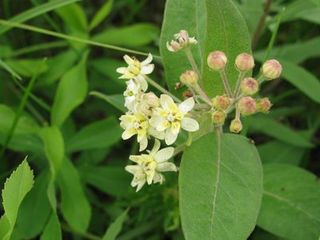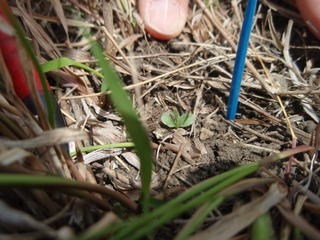|
|
Here’s a picture of a Stipa seedling in the Common Garden. I’m about to create a form for entering data on our seedlings. We are debating if we should count and measure each leaf or count leaves and measure the length of just the longest leaf. Most of our time will be spent finding the plants and/or the toothpicks that we put in to mark them. So, taking the measurements of each leaf shouldn’t add that much time. Any thoughts?
Stuart and I did an initial investigation of about 30 locations where Stipa was planted. We found plants at 40-50% of the locations! Caroline, what was your estimate for germination of these seeds?

Josh, Gretel, Hillary, and Ian are also trained on the TopScan to collect the GPS data. The ideal is that the radio signal is at 100% and the designation of the location is described as Fixed – (Float will do and Auto works if you are unable to connect to a radio signal)
Josh and I plan to collect from Hegg Lake and the road adjacent on Monday. In the quest to collect from 300 parent plants, we are likely onto roadsides – where we are trying to stay at least a meter off the road and using plants about 5m apart from each other. Generally, as the black color appears and as the capsule opens around the pointy head, the seeds are ripe and will pop off as you gently pull up the stem containing the seeds.
I plan to be around Sun afternoon and Mon. to finish the collection before starting to cross some plants.
Exciting news! Amy and Hillary found some seedlings at a Hegg Lake plot, the one thats on a hill (the hill with all the phlox on the side) near that blind corner. Anyway, there were nearby flowering plants so its great their reproducing! There were also a couple seedlings found outside the frisbee sized circle area.
here are the pics:

This one is a close up of the shriveled cots (with an achene next to it), can you see it!?!

The seedling finders, working hard!

This was in the morning, getting ready for work:

This is just a prairie lilly (Lilium philadelphicum) that I spotted at Staffenson. First time ever seeing one and I think their beautiful!

Lastly, this is a reminder for me to show Stuart my preliminary data collection sheet:
data table for project.pdf
-Katie
Stipa collection is going pretty well, aside from the Topcon being flaky and not connecting to the data network for improved accuracy (it should be good enough for refinding tags along with the metal detector). We’ve collected from 85 out of the desired 300 so far, with different averages of seeds collected depending on the site. Landfill and Staffenson both had rather high averages, somewhere around 9 or 10 (no math here, just guessing based on what I was entering in the data fields) while some of the scattered remnants were closer to 5 or 6.
As for today, I’ll be out with someone to go search at other sites, hopefully, but the weather is looking a bit questionable today. We’ll see!
This afternoon I spent some time with Terrasync, getting a data dictionary together for Hesperostipa seed collection. What does this mean?
This means I can take the GPS out, throw down a tag, collect some seed, then, while taking GPS points, put the various bits of information about the seed that I want directly into the Trimble. Geospatially referenced data with little effort!
Making sure that the GPS Pathfinder Office’s transfer utility is pointed at the right device (GPS Logger on Windows CE, in this case), you click “Send”, “Add” a data dictionary and browse to the file and Transfer All. You did create your data dictionary, right? No?
Well, take a step back and click on Data Dictionary Editor in the Utilities menu. From here, it’s pretty straightforward to create your very own data dictionary. Add the Features you want (features being the kinds of points you want. I added one for Stipa individual). From there, you add Attributes. These are the fields you want to take data on: whatever would be on your paper data sheet. Annoyingly, text fields are limited to a mere 100 characters, so keep that in mind for your comments fields (always have one; you never know!). Useful ones for me were Numeric (tip! if you want to widen the number entry field from the measly default of 2 characters wide, put some large number as your maximum value; you won’t be able to go above that, but that’s not a problem for my tag and envelope number fields. Certainly nothing will be above 1000000), Text, and Date. After getting your dictionary squared away, save it somewhere and transfer it to the Trimble.
At this point you should take the new data dictionary for a test run. Restart the Terrasync software on the Trimble and start anew. Create a new file and start taking a point. See if the dictionary suits your needs. If not, go back, fix your dictionary and retransfer, overwriting the old one. Now you’re collecting with style!
For the collection dictionary, I selected the following fields:
Tag Number (text)
Envelope Number (text)
# Seeds Collected (numeric)
Location (text)
Notes (text)
Notes2 (text; text is limited to 100 characters which may not be quite enough)
Current Date (date; autogenerated)
Collected By (text)

I’m back! You may have noticed all my photo links are broken… well, that website is dead and I can’t edit my old posts. I’ll go back through and comment on my posts with pictures with updated links so you can have a clue as to what’s going on.
I now keep a (nearly) daily photo blog on Blipfoto and will do weekly posts linking all of the photos from that week, along with other photos and posts as necessary.
As for my project this season, I’m interested in looking at the effects of humidity on the awns of Hesperostipa spartea (aka Stipa spartea. thanks, plant geneticists). The current idea is to construct some sort of variable-humidity chamber with a humidity guage readable by time-lapse photography. I expect this will involve a sealed chamber and a humidifier, dehumidifier, and some way to control them powering on and off. The seeds will be in the chamber, digging through artificial duff or maybe just looking at how the awns curl.
I realized not everyone can access a .docx file, so here is a PDF file link…
revised proposal.pdf
Hello everyone!
For those of you who aren’t familiar with me, I’m Katie. I attend Lakeland College in WI. I’m going to be a Junior this year majoring in Biology, and I’m excited to be writing my first FLOG entry 🙂
Here is a file link to my outline of the research I will be doing this summer! If you have any questions or possible additions to the experiment, do not hesitate to comment!
revised proposal.docx
Yesterday, Janelle G. and Shelby F. helped me do the May census on the Hegg Lake plot of my local adaptation experiment. There were some surprises, including 3 or 4 NEW seedlings!

Another surprise was a visit from this fawn.

Another interesting discovery was a cluster of egg sacs. Anybody know what critter would leave these?

Today and tomorrow we plan to census the two South Dakota plots that are part of this experiment.

With the early spring we’ve been having in Minnesota, I was curious about whether the Echinacea plants were sprouting. My husband and I made a day-trip out to Douglas County last Saturday (May 1). I did a quick check of my crossing experiment plot at Hegg Lake. I found some of the toothpicks we used to mark seedlings last summer, along with some of the plants–which are now a year old. I plan to do a complete census in another couple of weeks.

We also stopped by the common garden. Here’s one of the plants–already quite a bit of growth on the first of May.
|
|


-thumb-320x240-45985.jpg)
-thumb-320x405-45988.jpg)
-thumb-320x240-45993.jpg)
-thumb-320x240-45997.jpg)
-thumb-320x240-46001.jpg)





